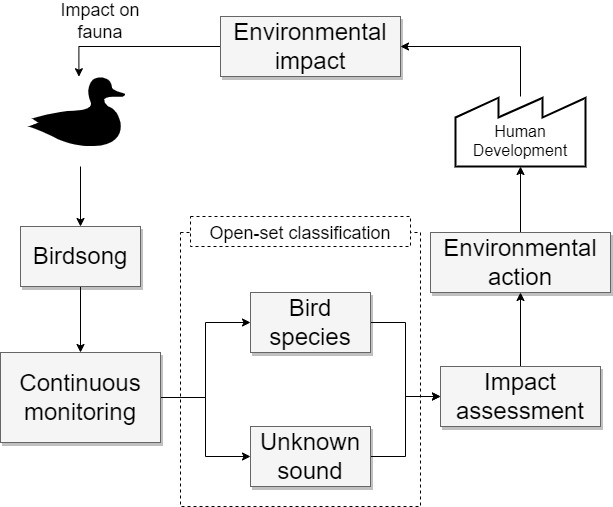Open-set classification approaches to automatic bird song identification: towards non-invasive wildlife monitoring in Brazilian fauna
Keywords:
wildlife monitoring, open-set classification, bird song identification, Brazilian faunaAbstract
Bird song identification has mainly been approached as a closed-set classification problem; that is, all samples are known to be from one of the classes known by the classifier. However, wildlife monitoring using bird songs is closer to an open-set classification setting, as the classifier is required to predict if a sample comes from an unknown origin, like an environmental sound or an unrelated animal. Furthermore, current approaches to bird song classification assume that the model can access the whole dataset and build optimal projections. This is not a realistic scenario in Brazil as the country has thousands of species, and it is unfeasible to build a dataset containing a representative diversity of samples of all of them. This work analyzes algorithms that can be used for the open-set classification of bird songs. The analyzed algorithms can fit models using data from one or from only a few species. The investigation revealed many current technical difficulties and highlighted several opportunities for future work in this field.
Downloads
References
World Bank, “Life expectancy at birth, total (years) | Data.” [Online].
Available: https://data.worldbank.org/indicator/SP.DYN.LE00.IN
——, “Literacy rate, adult total (% of people
ages 15 and above) | Data.” [Online]. Available:
https://data.worldbank.org/indicator/SE.ADT.LITR.ZS
H. Yang, M. Ma, J. R. Thompson, and R. J. Flower, “Waste
management, informal recycling, environmental pollution and
public health,” Journal of Epidemiology and Community Health,
vol. 72, no. 3, pp. 237–243, Mar. 2018. [Online]. Available:
https://jech.bmj.com/lookup/doi/10.1136/jech-2016-208597
S. Fawzy, A. I. Osman, J. Doran, and D. W. Rooney, “Strategies
for mitigation of climate change: a review,” Environmental Chemistry
Letters, vol. 18, no. 6, pp. 2069–2094, Nov. 2020. [Online]. Available:
https://link.springer.com/10.1007/s10311-020-01059-w
G. Plumecocq, T. Debril, M. Duru, M.-B. Magrini, J. P. Sarthou, and
O. Therond, “The plurality of values in sustainable agriculture models:
diverse lock-in and coevolution patterns,” Ecology and Society, vol. 23,
no. 1, 2018. [Online]. Available: https://www.jstor.org/stable/26799066
L. A. Martinelli, R. Naylor, P. M. Vitousek, and P. Moutinho,
“Agriculture in brazil: impacts, costs, and opportunities for a
sustainable future,” Current Opinion in Environmental Sustainability,
vol. 2, no. 5-6, pp. 431–438, Dec. 2010. [Online]. Available:
https://doi.org/10.1016/j.cosust.2010.09.008
C. D. Kolstad and F. C. Moore, “Estimating the Economic Impacts of
Climate Change Using Weather Observations,” Review of Environmental
Economics and Policy, vol. 14, no. 1, pp. 1–24, Jan. 2020. [Online].
Available: https://www.journals.uchicago.edu/doi/10.1093/reep/rez024
Y. Zhang, Y. Zhu, Z. Zeng, G. Zeng, R. Xiao, Y. Wang,
Y. Hu, L. Tang, and C. Feng, “Sensors for the environmental
pollutant detection: Are we already there?” Coordination Chemistry
Reviews, vol. 431, p. 213681, Mar. 2021. [Online]. Available:
https://linkinghub.elsevier.com/retrieve/pii/S0010854520307438
M. A. A. Salahuddin, I. S. Rohayani, and D. A. Candri, vol. 913, no. 1,
p. 012058, nov 2021. [Online]. Available: https://doi.org/10.1088/1755-
/913/1/012058
J. dos Santos Cerqueira, H. N. de Albuquerque, and F. de Assis
Salviano de Sousa, “Impact of the functioning of a thermeletry in
the bird fauna of the brazilian semiarid,” Revista Ibero-Americana de
Ciˆencias Ambientais, vol. 9, no. 2, pp. 71–83, Sep. 2017. [Online].
Available: https://doi.org/10.6008/cbpc2179-6858.2018.002.0007
R. Gula, J. Theuerkauf, S. Rouys, and A. Legault, “An audio/video
surveillance system for wildlife,” European Journal of Wildlife
Research, vol. 56, no. 5, pp. 803–807, Oct. 2010. [Online]. Available:
https://doi.org/10.1007/s10344-010-0392-y
D. P. Munari, C. Keller, and E. M. Venticinque, “An evaluation of field
techniques for monitoring terrestrial mammal populations in amazonia,”
Mammalian Biology, vol. 76, no. 4, pp. 401–408, Jul. 2011. [Online].
Available: https://doi.org/10.1016/j.mambio.2011.02.007
R. Shrestha, C. Glackin, J. Wall, and N. Cannings, “Bird Audio
Diarization with Faster R-CNN,” in Artificial Neural Networks and
Machine Learning – ICANN 2021, I. Farkaˇs, P. Masulli, S. Otte, and
S. Wermter, Eds. Cham: Springer International Publishing, 2021, vol.
, pp. 415–426.
J. SUEUR, “Cicada acoustic communication: potential sound
partitioning in a multispecies community from Mexico (Hemiptera:
Cicadomorpha: Cicadidae),” Biological Journal of the Linnean
Society, vol. 75, no. 3, pp. 379–394, 10 2008. [Online]. Available:
https://doi.org/10.1046/j.1095-8312.2002.00030.x
R. S. Schmidt, “Central Mechanisms of Frog Galling,” American
Zoologist, vol. 13, no. 4, pp. 1169–1177, Nov. 1973. [Online]. Available:
https://academic.oup.com/icb/article-lookup/doi/10.1093/icb/13.4.1169
S. E. Anderson, A. S. Dave, and D. Margoliash, “Template-
based automatic recognition of birdsong syllables from continuous
recordings,” The Journal of the Acoustical Society of America,
vol. 100, no. 2, pp. 1209–1219, Aug. 1996. [Online]. Available:
http://asa.scitation.org/doi/10.1121/1.415968
M. T. Lopes, L. L. Gioppo, T. T. Higushi, C. A. Kaestner, C. N.
Silla Jr., and A. L. Koerich, “Automatic bird species identification for
large number of species,” in 2011 IEEE International Symposium on
Multimedia, 2011, pp. 117–122.
R. H. Zottesso, Y. M. Costa, D. Bertolini, and L. E. Oliveira, “Bird
species identification using spectrogram and dissimilarity approach,”
Ecological Informatics, vol. 48, pp. 187–197, 2018. [Online]. Available:
https://www.sciencedirect.com/science/article/pii/S1574954118300888
W. J. Scheirer, A. de Rezende Rocha, A. Sapkota, and T. E. Boult,
“Toward open set recognition,” IEEE Transactions on Pattern Analysis
and Machine Intelligence, vol. 35, no. 7, pp. 1757–1772, 2013.
S. Li, “Content-based audio classification and retrieval using the nearest
feature line method,” IEEE Transactions on Speech and Audio Process-
ing, vol. 8, no. 5, pp. 619–625, 2000.
X.-l. Li, Z.-l. Du, and Y.-f. Zhang, “Kernel-based audio classification,” in
International Conference on Machine Learning and Cybernetics,
, pp. 3313–3316.
Y. Zhu, Z. Ming, and Q. Huang, “Automatic audio genre classification
based on support vector machine,” in Third International Conference on
Natural Computation (ICNC 2007), vol. 1, 2007, pp. 517–521.
Xenocanto Foundation, “Xenocanto,” https://xeno-canto.org/.
C. Cortes and V. Vapnik, “Support-vector networks,” Machine
Learning, vol. 20, no. 3, pp. 273–297, Sep. 1995. [Online]. Available:
https://doi.org/10.1007/bf00994018
L. van der Maaten and G. Hinton, “Visualizing data using t-sne,” Journal
of Machine Learning Research, vol. 9, no. 86, pp. 2579–2605, 2008.
[Online]. Available: http://jmlr.org/papers/v9/vandermaaten08a.htm


